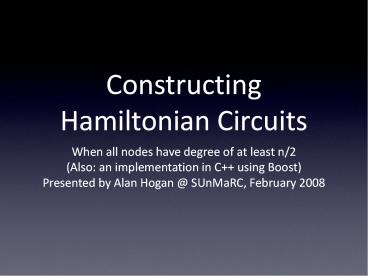Constructing Hamiltonian Circuits - PowerPoint PPT Presentation
Title:
Constructing Hamiltonian Circuits
Description:
A graph is a collection of vertices (or points) and edges (which connect the vertices) ... Pigeons = edges from A or B = 2(n/21) = n2. A. B. Worst case ... – PowerPoint PPT presentation
Number of Views:372
Avg rating:3.0/5.0
Title: Constructing Hamiltonian Circuits
1
Constructing Hamiltonian Circuits
- When all nodes have degree of at least n/2
- (Also an implementation in C using Boost)
- Presented by Alan Hogan _at_ SUnMaRC, February 2008
2
Graphs
- A graph is a collection of vertices (or points)
and edges (which connect the vertices).
3
Example Graph
Vertex
Edge
4
Paths and Circuits
- Paths are series of vertices connected by edges
- A circuit is a closed path (starts ends at the
same vertex)
5
Path
Circuit
Start
Start
End
End
6
Hamiltonian Circuits
- A Hamiltonian circuit is a closed path which
visits every vertex in the graph exactly one time - Also called Hamiltonian Cycles
7
Plain Circuit
Hamiltonian
8
Problem
- General algorithms to find Hamiltonian circuits
are slow, running in non-polynomial time it is
an NP-complete problem - We can use an efficient algorithm, however, in
some cases, thanks to Dirac and Ore...
9
Diracs Theorem (1952)
- A simple graph with n vertices (n gt 2) is
Hamiltonian if each vertex has degree n/2 or
greater. - (sufficient but not necessary)
10
Ores Theorem (1960)
- Generalization of Diracs Theorem
- If G is a simple graph with n vertices, where n
3, and if for each pair of non-adjacent vertices
v and w, deg(v) deg(w) n, then G is
Hamiltonian
11
Also in Ores paper...
- Ores restatement of Diracs principle lends
itself to an interesting useful principle - For graphs satisfying the pre-requisite
condition, an existing almost-complete
Hamiltonian circuit with a gap between vertices A
and B where there should be the final edge can
be repaired.
12
Using Ores Algorinthm
- Find a two vertices C D s.t. edges (A,C) and
(B,D) exist (C,D) is in our almost-complete
circuit and D lies between C and A on the
partial circuit. - Connect vertex A to vertex C
- Connect vertex B to a vertex D
- Remove the edge between those two earlier
vertices.
D
A
C
B
Missing edge
Repaired Full circuit
13
Steps of Ores principle
- Find a set of vertices s.t. edges (A,C) and
(B,D) exist, and (C,D) is an edge in our
almost-complete Hamiltonian circuit. - Connect vertex A to vertex C
- Connect vertex B to a vertex D
- Remove the edge between those two earlier points.
14
Project Scope
- Generally, finding a Hamiltonian path takes O(n!)
time - NP-complete problem - This project deals exclusively with graphs of the
type described by Ore. - For these graphs, we can quickly (in polynomial
time) find the Hamiltonian path
15
Why does that work?
- We know that at least one pair of such desirable
contiguous earlier vertices C and D exist because
each vertex has at least half as many edges as
there are vertices - Proof by the pigeonhole principle
- Boxes potential pairs of vertices C D n-3
- Pigeons edges from A or B 2(n/2-1) n-2
16
Worst case(Edges not connected to A or B and not
on the circuit are not depicted)
A
B
D
C
17
Repeated Use
- Repeated use of the algorithm suggested by Ores
paper allows us to find a Hamiltonian circuit for
any graph in our scope (all vertices have at
least n/2 edges)
18
Our Algorithm
- Pretend we have a circuit
- Acknowledge one pretend edge does not really
exist - Fix that edge. We have a pretend circuit again,
but its closer to true - Go back to step 2. Repeat until all edges really
exist
19
Repeating the Algorithm
- Pretend we have a circuit
- Acknowledge one pretend edge does not really
exist - Fix that edge. We have a pretend circuit again,
but its closer to true - Go back to step 2. Repeat until all edges really
exist
A
B
C
D
20
Repeating the Algorithm
- Pretend we have a circuit
- Acknowledge one pretend edge does not really
exist - Fix that edge. We have a pretend circuit again,
but its closer to true - Go back to step 2. Repeat until all edges really
exist
C
B
A
D
21
Implementation
- The algorithm as discussed was slightly modified
to use two graphs the pretend circuit, and the
true graph - Implemented in C using the Boost graph library
and Xcode - Command-line only (but a GUI frontend could be
constructed)
22
Thank you.
- alanhogan.com/asu/hamiltonian-circuitRead more
about this project,download this presentation,
or get a copy of the source code online.
23
(No Transcript)































